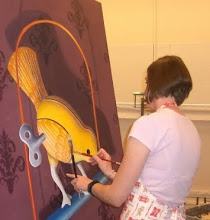 I can't seem to get enough of peregrine falcon chicks! This little guy, entitled Love Me, is painted directly onto a mounted piece of vintage wallpaper.
I can't seem to get enough of peregrine falcon chicks! This little guy, entitled Love Me, is painted directly onto a mounted piece of vintage wallpaper.For me, wallpaper is the epitome of "home". It represents civilization, life, and humanness. It is taking a space and making it a permanent area to live.
I had a fantastic art teacher, Ms. Sylvestri, who referred to setting up our work space at the beginning of each class as "building our nest". "When you get your nests set up, come to me with questions", she would say.
I have never really put the two together until just now, but decorating your personal space with wallpaper or any other means of personalization in order to make a more comfortable environment for you and your family is just that - building a nest.
Placing the subject (a bird) in an environment that it does not belong (a home) has been an extremely enticing juxtaposition to me. With every painting I try to gain a greater understanding of this comparison. Animal vs. man and wild vs. civilization are extremely overwhelming topics when looking at the entire picture. I'll just have to take it bite by bite instead.

